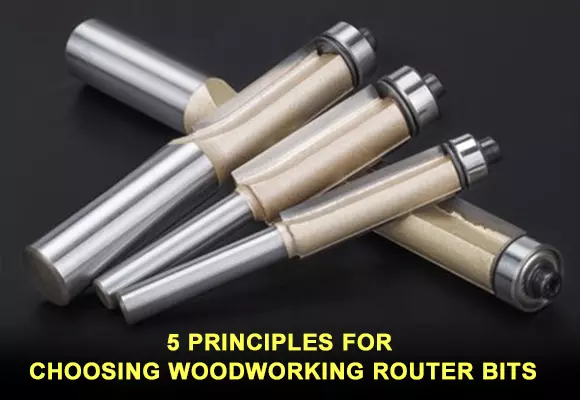
5 Principles for Choosing Woodworking Router Bits
Router bits are widely used in woodworking. No matter for personal use or used in machine processes, router bits are highly efficient tools. Especially carbide router bits. With good wear resistance and long service life, carbide router bits have been used in homes and factories. But what is the accordance for choosing router bits? Price matters but is not the main reason. Here we collect 5 principles for choosing woodworking router bits as follows.

1. Material to be cut by router bits
No matter what kind of tools you are going to use, the first thing we should consider is the material to be processed. The material decides your tools’ materials. And it also worked on woodworking router bits. After all, what we are going to process is not just wood.
Wood cutting objects can be mainly divided into solid wood and wood-based composites, and solid wood can be divided into soft, hard and modified materials treated wood, etc. Wood composite materials include plywood, veneer laminated timber, particleboard, oriented strand board, flake board, gypsum particleboard, cement particle board, hard fibreboard, medium-density fibreboard(MDF), high-density fibreboard, core board, glued timber, etc. There are also some wood or wood composite material workpieces veneered on one or both sides.
Wood composite material is a composite material composed of wood monomers, such as veneer, shavings, or fibers. They are mixed together under certain temperatures and pressure by adhesives. Its properties are determined by wood monomers, arrangement of chips, and properties of adhesives. Cutting properties will also show differences because of their structure and the proportion and nature of additives. For example, MDF is nearly isotropic, and cutting resistance is almost the same everywhere on one board. As for particle boards, due to their uneven paving density and discrepancy between their surface and internal structure, there’s a relatively big difference in cutting resistance on different places of one board. Core-board is made of solid wood slats. The direction of grain between two slats is different, so when you deal with this kind of board, the processing performance is the same with solid wood sometimes.

2. Cutting direction
Wood is a kind of high polymer natural material. It is a natural growth and composed of wood fiber which arranged in a certain way. One of the biggest features of wood is anisotropy. So there are different ways of cutting direction. Vertical, horizontal, end and transition cutting in the solid wood cutting process can be usually seen.
When cutting solid wood, according to the direction of blades relative to wood fiber, wood cutting is divided into the longitudinal, transverse, end, and longitudinal, longitudinal, and transverse cutting direction.
3. Tool rotation direction and feed direction
Choosing the right tilt direction of blade edges on your tools according to the rotation direction of tool shafts and direction of wood workpiece feeds.
4. Stability of your workpiece
There are several things we should pay attention to about the stability of tools and workpieces in the cutting process. Workpiece stability refers to the smooth feed of your wood workpiece during the cutting process without any beats. To strengthen the stability of your workpiece, the main measures we adopted are to reduce the workpiece’s center of gravity and increase the contact area. Therefore, for the vertical installation of forming router bits, large diameter router bits in the form of installation is conducive to improving the stability of the workpiece processing, but at the same time stability of the tool has decreased. To improve the stability of the tool, except good dynamic balance, we also need its structure, installation size, and quality to meet the requirements of stability standards, such as the tool rotary frequency and the natural frequency of the tool should be separated by a certain number of values, and different materials of the cantilever installation size of the tool should be limited.
5. Machining surface quality requirements
The quality of the wood workpiece’s surface is influenced by the surface roughness, geometric dimension, and shape and position accuracy. The surface’s quality relates to geometric parameters and shape and location accuracy of the router bit. Also, it relates to the fitting precision of router bits, stability of router bits, movement precision, and vibration of machine tools. Ripples on the surface of router bits are highly associated with feeds per tips on router bits. Therefore, reducing feed speed, increasing rotation speed, the number of cutter teeth, and increasing the diameter of router bits can reduce the surface ripple height and improve surface quality.
According to these 5 principles for choosing woodworking router bits, we can now summarize them into several parts. First, before doing cutting work, you need to make sure your router bit suits your workpiece’s material. Compared with HSS router bits, carbide router bits with good wear resistance have a wider range of applications and long service life. Secondly, due to the features of wood board, there are different cutting directions, choosing the right router bits for the right places. Thirdly, choose blades that have the right tilt direction of edges. Besides, make sure your router bits meet standard requirements. Finally, it depends on your workpiece’s surface condition and what kind of surface you want to get.
Konetool provides high-quality carbide router bits of different shapes and sizes. If you have any demands, just contact us.